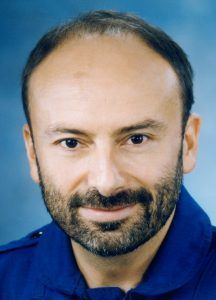
Home - Search - Browse - Alphabetic Index: 0- 1- 2- 3- 4- 5- 6- 7- 8- 9
A- B- C- D- E- F- G- H- I- J- K- L- M- N- O- P- Q- R- S- T- U- V- W- X- Y- Z
Malerba, Franco Egidio
FURTHER INFORMATION ON THIS TOPIC AT OUR PARTNER SITE
 Malerba Credit: www.spacefacts.de |
Status: Inactive; Active 1989-1992. Born: 1946-10-10. Spaceflights: 1 . Total time in space: 7.97 days. Birth Place: Genova.
Educated Genova.
NASA Official Biography
- NAME: Franco Malerba (Ph.D.)
- ASI Astronaut (Payload Specialist)
- PERSONAL DATA:
- Born October 10, 1946, in Genova, Italy. Married to the former Marie-Aude Némo. They have one child. Recreational interests include mountaineering, skiing, and tennis. He is fluent in Italian, English, and French.
- EDUCATION:
-
1965 Maturita classica (Lyceum). 1970 University degree, Electronics Engineer, University of Genova, Italy, specializing in the telecommunications field (laurea 110/110 cum Laude). 1974 Doctorate in Physics, University of Genova, (110/110) specializing in Biophysics (after research work at the Italian National Research Council and at the National Institutes of Health, Bethesda, Maryland, USA). - ORGANIZATIONS:
- Founding Member of the Italian Space Society (ISS).
- RESEARCH ACTIVITIES:
-
1970-75 Research Assistant at the Italian National Research Council (CNR) Laboratorio de Biofisica e Cibernetica (Genova) carrying experimental work on membrane biophysics (using squid axons) and biological membrane modeling with lipid bilayers. 1971 Lecturer of Cybernetics and Information Theory at the Physics Faculty, University of Genova. 1972 Summer Research Assistant at the Nato Saclant Research Center (La Spezia, Italy) working on computer-aided signal detection methodologies for sonar data systems. 1972-74 Research Fellow at the National Institutes of Health (Bethesda, Maryland) designing, developing, testing and using a fast micro-spectrophotometer for research on photoreceptors biophysics (using frog retinas). 1977-80 In 1977, Dr. Malerba was chosen by the European Space Agency (ESA) as one of four European Payload Specialist Candidates for the first Spacelab mission. After this selection he became a staff member at the European Technical Center (ESTEC) of ESA Space Science Department, Space Plasma Physics Division, working in the development, testing, and qualification of ES020 - PICPAB, an experiment in Ionospheric Plasma Physics for the first Spacelab payload, flown in 1983, involving the use of accelerated charged particle beams (cooperation involved French CNRS/CRPE, Norwegian NRDE and ESTEC). - INDUSTRY EXPERIENCE:
-
1976-89 Held technical and technical management positions with Digital Equipment in Italy and in Europe. He worked mainly in the field of multiprocessor systems (Paris 1976, Milan 1977), computer networks engineering (Geneva 1981-85), and telecommunications technology (Rome 1986-88, and Sophia Antipolis in 1989). - MILITARY STATUS:
- Reserve Officer, Italian Navy. Served in 1974-75 (Sottotenente Armi Navali); was assigned to the Destroyer San Giorgio as Science Lecturer to the Navy Academy, and then to the Mariperman Technical Center in La Spezia working on ELF transmission systems.
- OTHER SKILLS:
- Obtained scuba diving license from the Calypso Scuba Club, Geneva (1984).
- FLYING STATUS:
- Obtained Private Pilot License (College Park, Washington, D.C., 1973) and then the equivalent Italian flying license.
- NASA EXPERIENCE:
- After the Payload Specialist selection in 1989 by the Italian Space Agency (ASI) and NASA for the TSS-1 mission, he became a staff member of ASI and was assigned to the NASA Johnson Space Center, Houston, Texas, for training. In September 1991, he was designated Prime Payload Specialist for the TSS-1 mission. Dr. Malerba flew as the first Italian citizen in space on STS-46 (July 31, 1992 to August 7, 1992). He is now involved with the Italian Space Agency (ASI) manned space flight program follow-on activities.
More at: Malerba.
Family: Astronaut. Country: Italy. Flights: STS-46. Projects: STS. Bibliography: 12, 5739.
1946 October 10 - .
- Birth of Franco Egidio Malerba - . Nation: Italy. Related Persons: Malerba. Italian biologist payload specialist astronaut 1989-1992. First Italian astronaut. ESA; STS-46 Mission TSS-1. 1 spaceflight, 8.0 days in space. Flew to orbit on STS-46 (1992)..
1992 July 31 - . 13:56 GMT - . Launch Site: Cape Canaveral. Launch Complex: Cape Canaveral LC39B. Launch Platform: MLP1. LV Family: Shuttle. Launch Vehicle: Space Shuttle.
- STS-46 - .
Call Sign: Atlantis. Crew: Allen, Andy,
Chang-Diaz,
Hoffman,
Ivins,
Malerba,
Nicollier,
Shriver.
Payload: Atlantis F12 / Eureca 1 / TSS 1. Mass: 12,965 kg (28,582 lb). Nation: USA.
Related Persons: Allen, Andy,
Chang-Diaz,
Hoffman,
Ivins,
Malerba,
Nicollier,
Shriver.
Agency: NASA Houston.
Program: STS.
Class: Manned.
Type: Manned spaceplane. Flight: STS-46.
Spacecraft Bus: Shuttle.
Spacecraft: Atlantis.
Duration: 7.97 days. Decay Date: 1992-08-08 . USAF Sat Cat: 22064 . COSPAR: 1992-049A. Apogee: 437 km (271 mi). Perigee: 425 km (264 mi). Inclination: 28.50 deg. Period: 93.20 min.
Manned seven crew. Deployed Eureca-1; failed to deploy Italian tether probe TSS-1. Payloads: Tethered Satellite System (TSS)-1; European Retrievable Carrier (EURECA)-1L; Evaluation of Oxygen Integration with Materials (EOlM)-lll/ Thermal Energy Management Processes (TEMP)-2A; Consortium for Materials Development In Space Complex Autonomous Payloads (CONCAP)-ll and Ill; IMAX Cargo Bay Camera (ICBC); Limited Duration Space Environment Candidate Materials Exposure (LDCE); Pituitary Growth Hormone Cell Function (PHCF); Ultravio-let Plume Instrument (UVPl).
1992 August 8 - .
- Landing of STS-46 - . Return Crew: Allen, Andy, Chang-Diaz, Hoffman, Ivins, Malerba, Nicollier, Shriver. Nation: USA. Related Persons: Allen, Andy, Chang-Diaz, Hoffman, Ivins, Malerba, Nicollier, Shriver. Program: STS. Flight: STS-46. STS-46 landed at 13:13 GMT. .
Back to top of page
Home - Search - Browse - Alphabetic Index: 0- 1- 2- 3- 4- 5- 6- 7- 8- 9
A- B- C- D- E- F- G- H- I- J- K- L- M- N- O- P- Q- R- S- T- U- V- W- X- Y- Z
© 1997-2019 Mark Wade - Contact
© / Conditions for Use